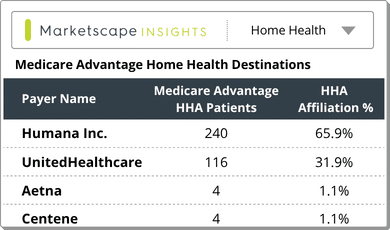BLOG
Webinar Recap: Reframing Your Business Development Strategies
By: Ashton Harrison | September 3, 2020
The landscape of healthcare marketing and business development is constantly evolving. With COVID-19, regulation changes, and more emphasis placed on total cost of care, physicians and hospitals are looking for quantifiable reasons to partner with post-acute care providers. To discuss the best ways to adapt to these changes, we recently held a live webinar with two industry experts who shared ways leading organizations in the post-acute care industry are reinventing their strategies. If you missed the webinar, check out the on-demand recording.
The webinar speakers included Cindy Campbell, Director of Operational Consulting at WellSky, and Sharon Harder, President of C3 Advisors, LLC. Trella’s Director of Product Marketing, Kirsten Reed, hosted the webinar. In addition to the great insights shared by our panelists, our audience questions brought more topics to light. Here’s a quick recap of what we discussed:
What observations have you made concerning agencies’ business development efforts in a market impacted by change?
Cindy answered this question by describing the importance of agencies positioning their business strategies to meet the mindset of their partners. She harped on the importance of being aware of challenges and needs when it comes to best practices for marketing and business development. The big changes, such as the Patient-Driven Groupings Model (PDGM), Medicare Advantage, and COVID-19, are disruptions to be conscious of. With COVID-19, Cindy has observed the value of communication when working with partners, including transparency on patient capacity and resource offerings. Another point Cindy made is that although relationship building is still important, factors such as patient outcomes, hospitalization rate, and performance over competitors can greatly influence relationships with referral partners. Data brings value, and you cannot simply rely on relationships any longer. Lastly, In regards to post-acute partnerships, Cindy shared how collaboration between post-acute providers and forming partnerships to create a continuum path for managing care at the lowest cost, with the best outcomes, is what CMS is aiming for.
Sharon’s answer to this question involved the awareness of the difficulties COVID-19 brought to business development teams who were no longer able to visit referral partners in person. On the other hand, for home health agencies, COVID-19 created new opportunities for agencies to market themselves as a better option for patients leaving the hospital versus being sent to a skilled nursing facility (SNF). Instead of viewing each other as competitors, Sharon feels collaboration between home health and SNF’s would allow both groups to be more successful and place patients in the most optimal post-acute care setting possible. Sharon agreed with Cindy on the importance of being aware of industry and regulatory changes – those happening now and those anticipated – and how you must be aware of the effect they will have on your partners.
Are there specific changes that you’ve observed in how agencies are using data to drive their strategic business development?
Sharon began her answer by identifying how post-acute business development teams are beginning to reassess and remeasure the market in terms of current conditions and opportunities that are newly identified due to COVID-19. Because remote encounters for hospice and home health are not visible, agencies will need to find new ways to measure and track those encounters. For example, sales and marketing teams should consider the impact and meaning of lower home health and hospital utilization statistics and new ways to prove quality care delivery. She reiterated the need to analyze how care delivery is changing and how the industry should be measuring and focusing on their competitive advantages to benefit referral sources.
Cindy started by mentioning the book “Positioning: The Battleground for Your Mind,” written by Ries and Trout. She stated that to better understand your positioning, data should be used to improve your awareness of your partners, including who your top referral sources are, what new referral partners you should be targeting, the demographics and cohorts of the patients they serve, and their patients’ networks. Also, up-to-date data is crucial to reflect your outcomes, such as low hospitalization rates. Outdated data will reflect poorly if there are areas your agency has recently improved upon.
What other types of data would be most beneficial for agencies to use, and why?
Cindy’s answer was any data that will help you perform a SWOT (strengths, weaknesses, opportunities, and threats) analysis. To compete against others in your area, identifying strengths will set your organization apart, especially if specific metrics can be shown. On the other hand, using data to identify weaknesses is a great way to focus on the areas your agency can improve on. To find new opportunities, data may identify strong referral partners that you’re not currently focused on. Lastly, data can be used to recognize threats and biggest competitors, and what outcomes or resources your competitors offer that you may not. From another angle, Cindy mentioned how data can be used to identify new competitors, particularly as the post-acute industry continues to grow. This information is also valuable if your business has an interest in expanding to new locations and is seeking insights into demographics and competitors in specific zip codes. Data will allow you to identify these areas to further innovate and grow.
Sharon’s response to this question involved the topic of the 2021 PPS outpatient rule, which will involve eradicating the inpatient-only list. CMS plans to take 300 additional musculoskeletal procedures off the list soon and will abolish the inpatient-only list over three years. This will bring new referral opportunities as agencies analyze newly relevant outpatient data, potential physician referral partners, and patients who will need their services.
How are data-driven initiatives shifting the way that sales teams conduct day to day activities, such as territory planning for those sales reps and business development leaders?
Sharon shared her opinion on how data allows sales teams to utilize factual analysis of the market and achieve a plan that will allow teams to work smarter rather than harder. Data identifies pain points and potential correlation and makes it easier to come up with solutions that will please referral partners. Additionally, business development teams can come to meetings more prepared with value-added propositions
Cindy agreed with Sharon and feels that times are changing now that sales reps have improved strategies and data resources to avoid simply driving the zip codes. Less time is wasted by being data smart, and emphasis should be placed on tracking referral patterns. How many patients were referred last month, and did those numbers drop at all? If you’re made aware that referrals did decline, you are empowered to find out why.
Following our four key discussion points, the floor was opened to audience questions:
What is the value behind positioning your business?
Cindy answered this by explaining the psychology of marketing and branding, and the success you will find by positioning your organization as a leader in your community. Data that reflects this position is incredibly valuable, too.
How can our agency incorporate data into our current outreach efforts and marketing collateral?
Kirsten answered this question by stating the importance of performing a competitive analysis and tracking how metrics have changed quarter over quarter. This may mean monitoring readmission rates, total cost of care, and market share. Also, using data to confirm your top referral partners are referring as much as they may say they are. Also, exploring your market to see what new referral sources may be available in your area.
In regards to incorporating data into marketing collateral, you should promote your areas of strengths and incorporate specific metrics. If you’re agency is seeking new ideas for creating collateral, Trella created a leave behind template that is a great starting point for creating a marketing resource.
Can you expand on what data we should be looking at regarding outpatient settings?
Cindy stated that with outpatient settings, you’ll want to identify what types of patients they serve using ICD 10 codes and diagnostic cohorts. From there, identifying how they fit with your business strengths and if you have a program crafted to serve those types of patient cohorts. Sharon added on to this by saying agencies should begin identifying physicians and surgeons they may want to begin targeting. Start by learning what patients they’re working with, where they’re affiliated, and then identify the ASC or surgery center and present yourself.
We’re so grateful for the participation of our speakers and audience. Hopefully, this discussion has sparked ideas for new strategies to help your business grow. If you’re ready to get started updating sales plans and marketing materials, Trella customers can view Q1 2020 Medicare claims data, which, for our Home Health customers, also includes the first quarter of PDGM data. Log into Marketscape today to access your new insights.
Not a Trella Health customer yet? Learn more about our market intelligence solution, Marketscape, today!
If you have more questions for our speakers, would like to participate in a future panel discussion, or if your team has discovered new ways to improve your business development, we would love to know! Join our Post-Acute Care Leadership Network on LinkedIn to share your thoughts and ideas. For more helpful tools, from email marketing best practices to finding success with an effective website, check out our free resources.














